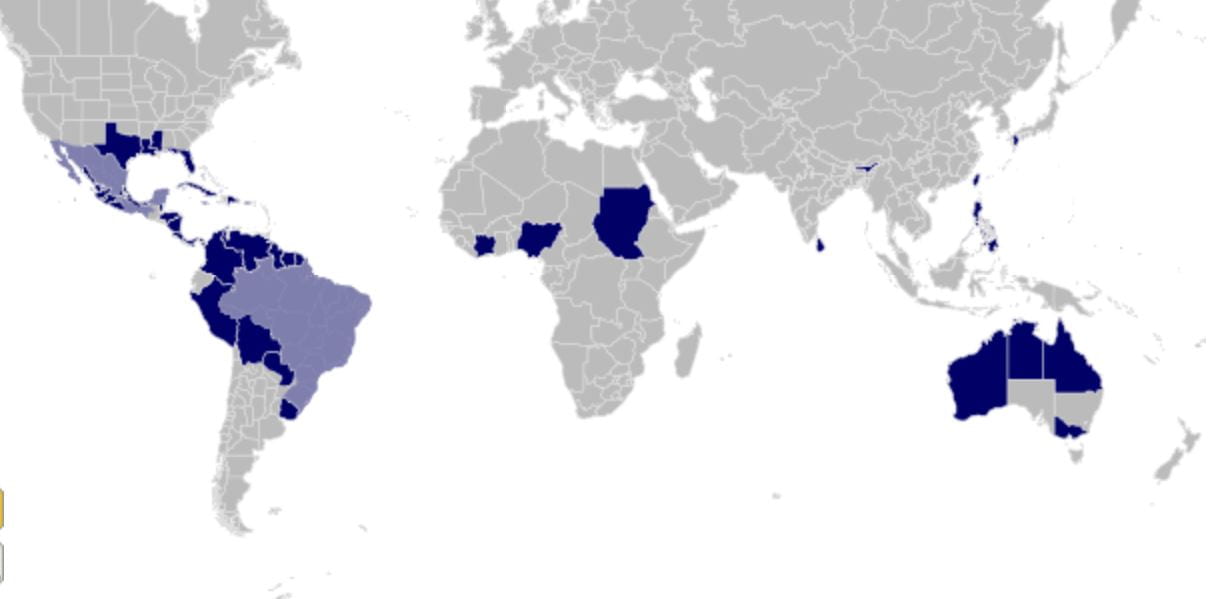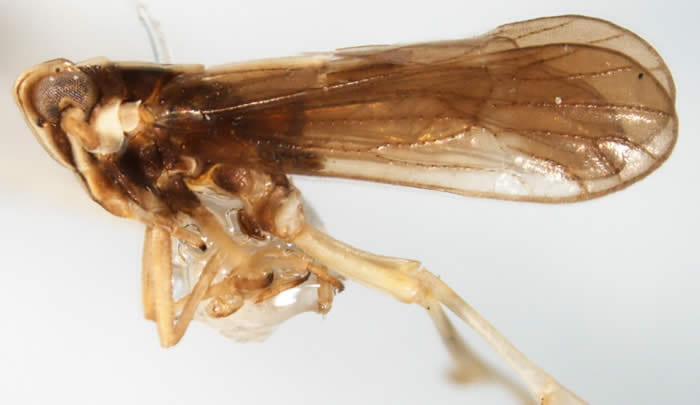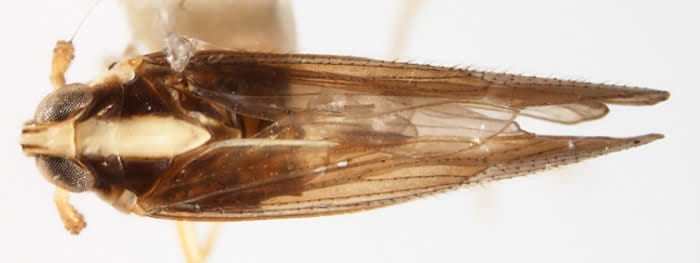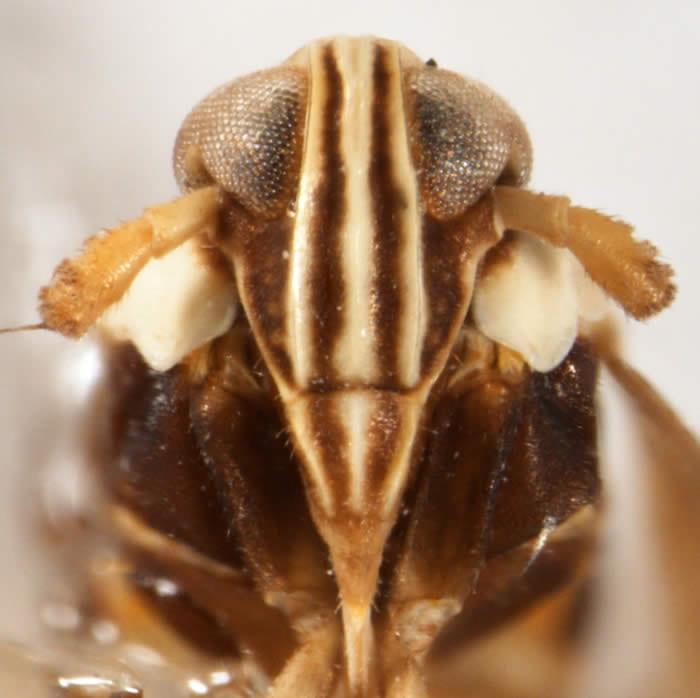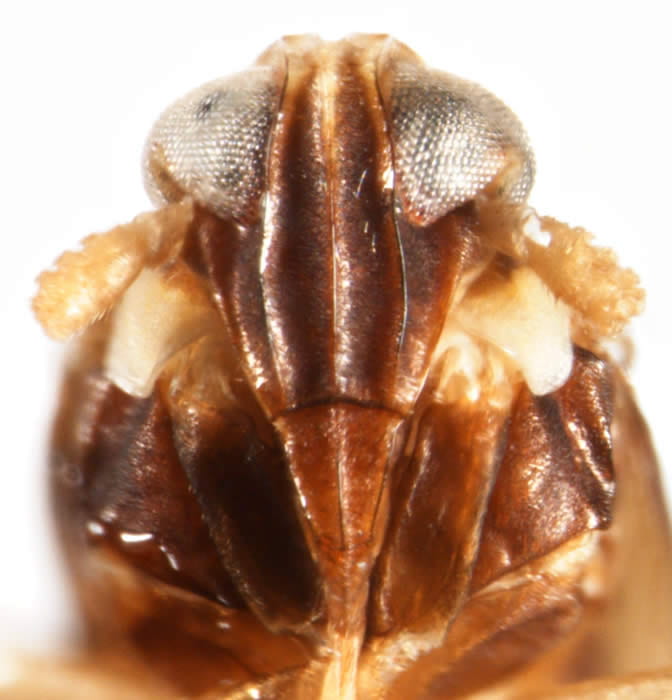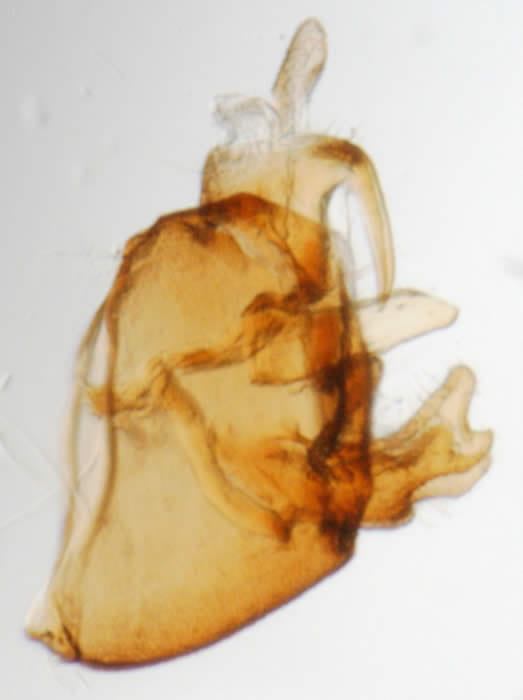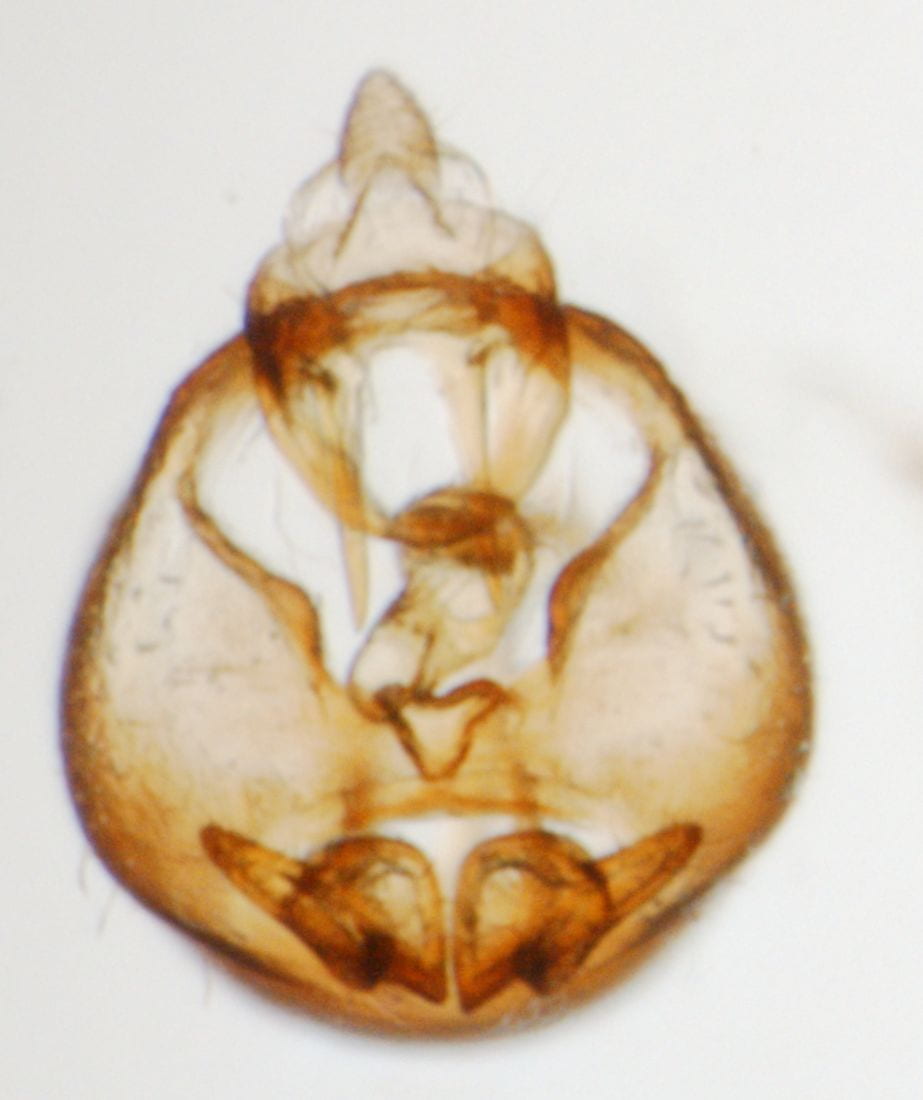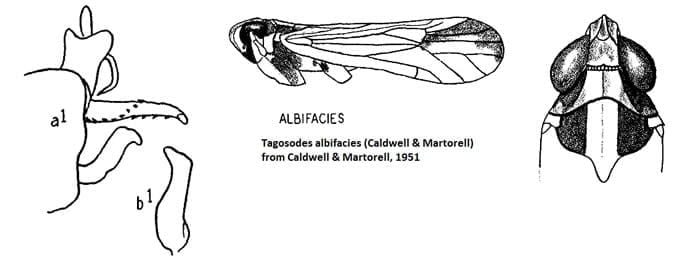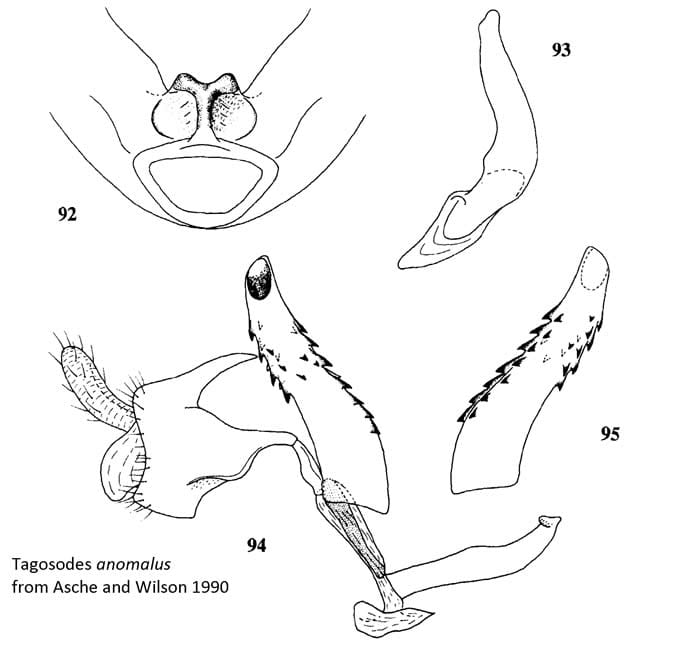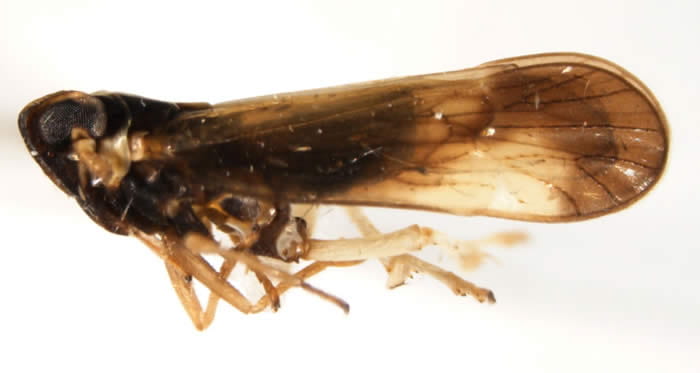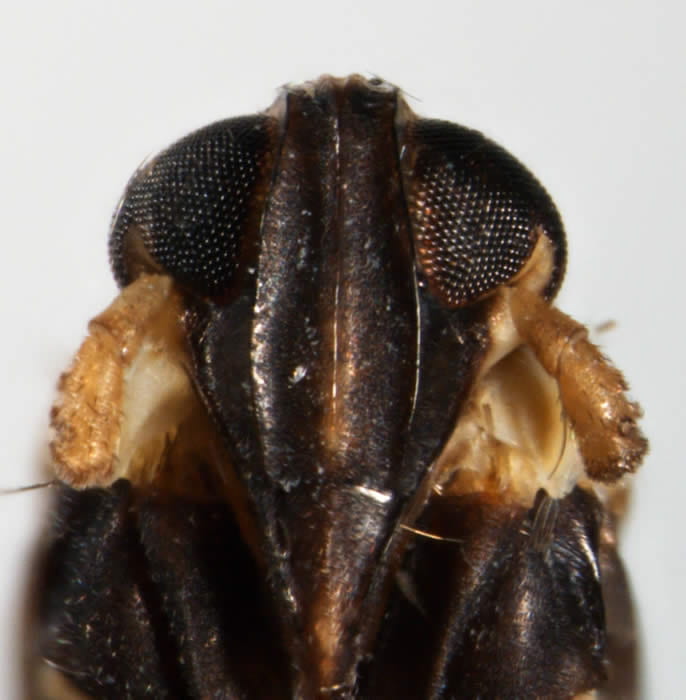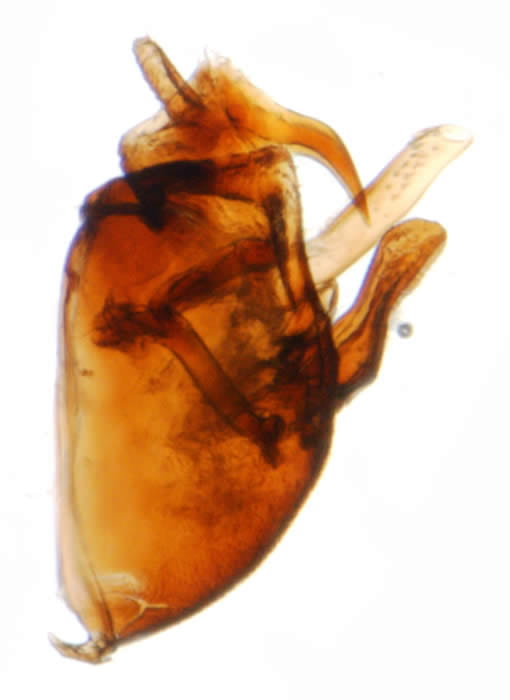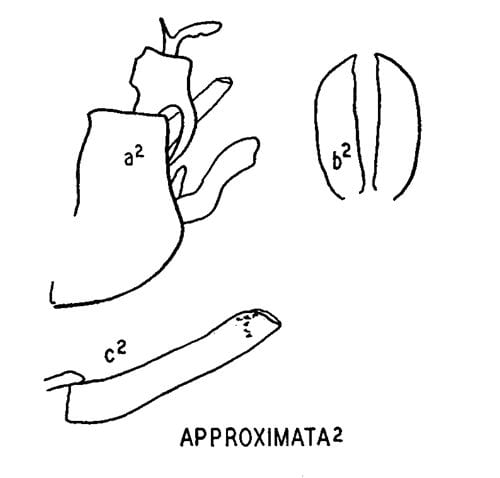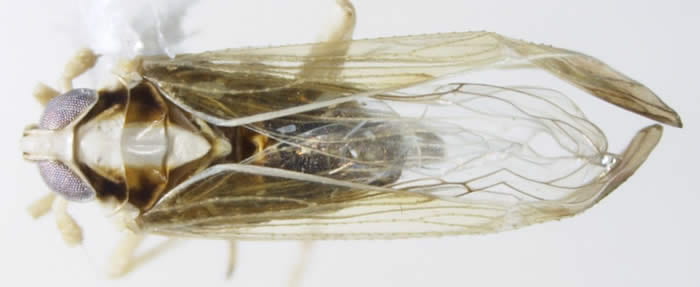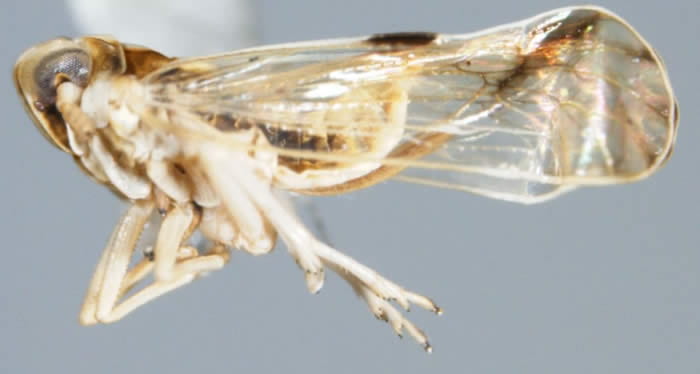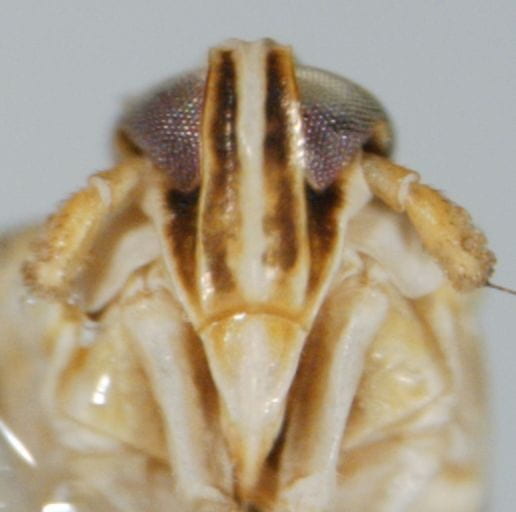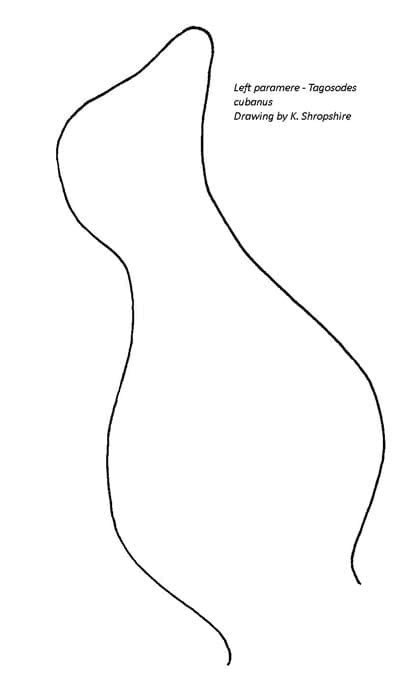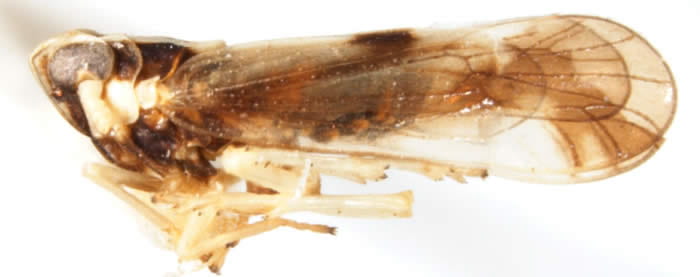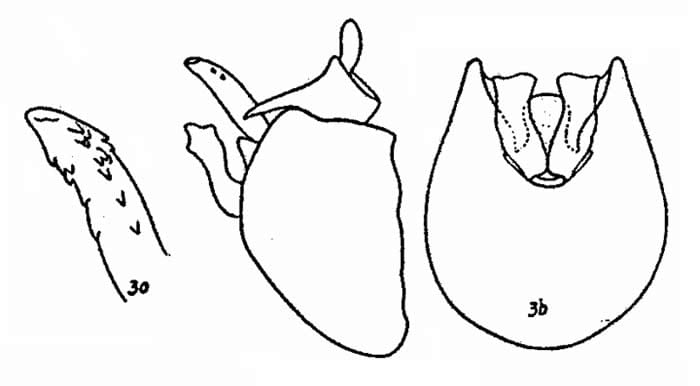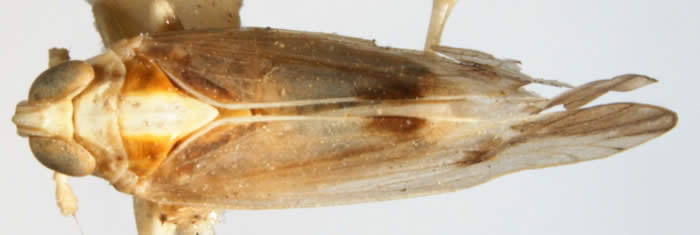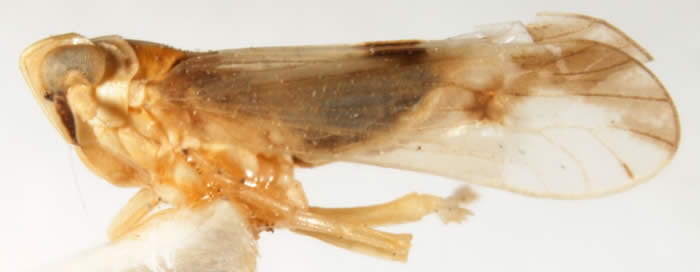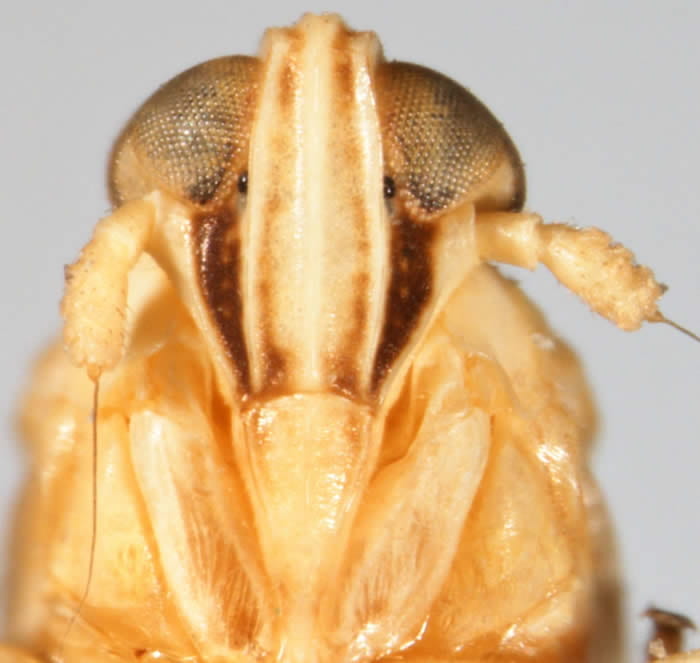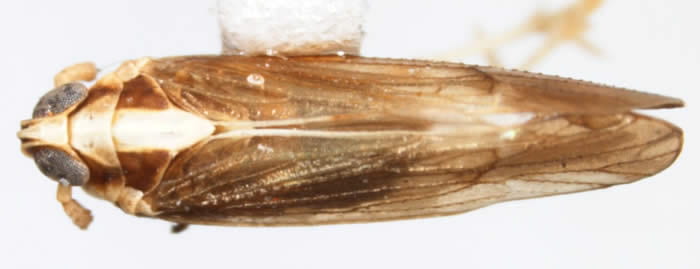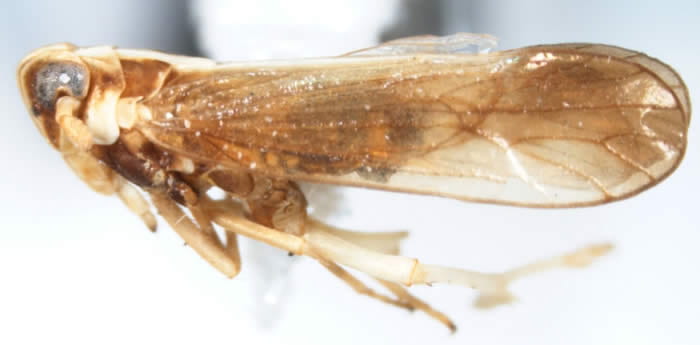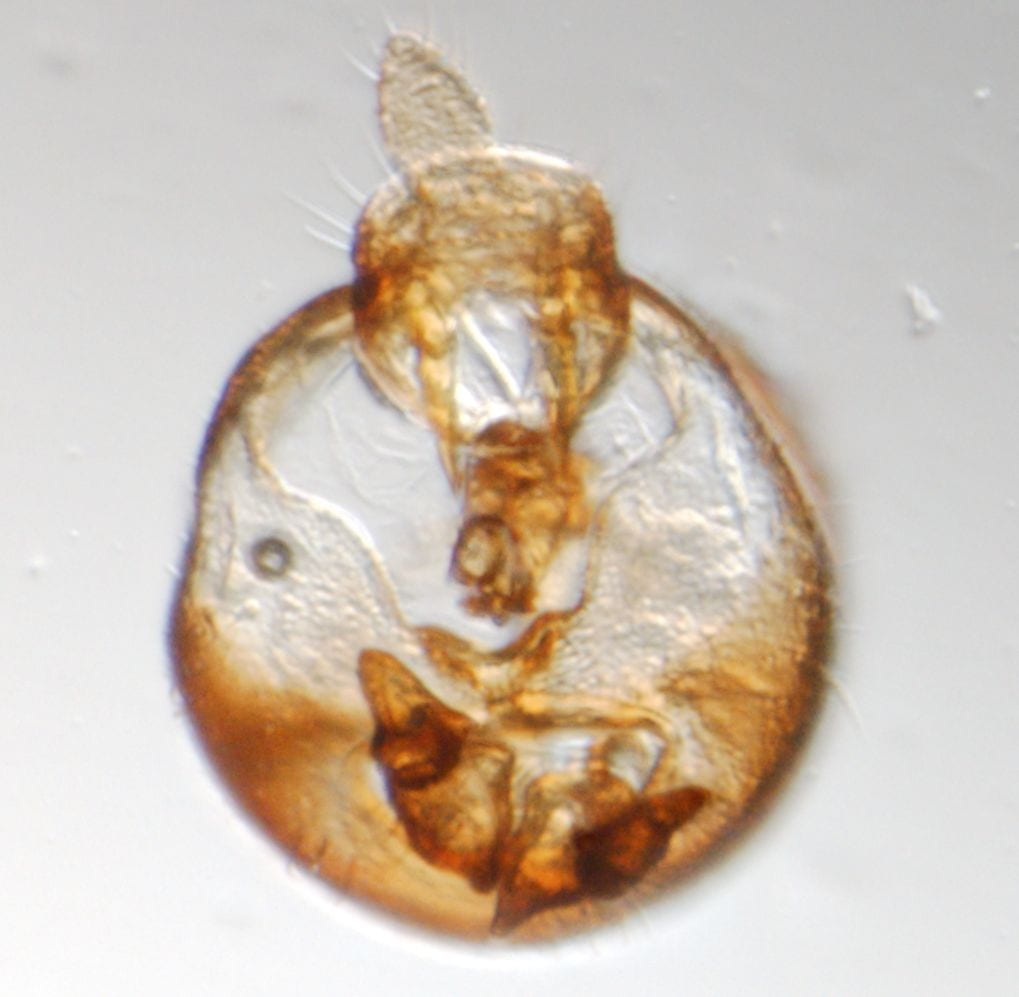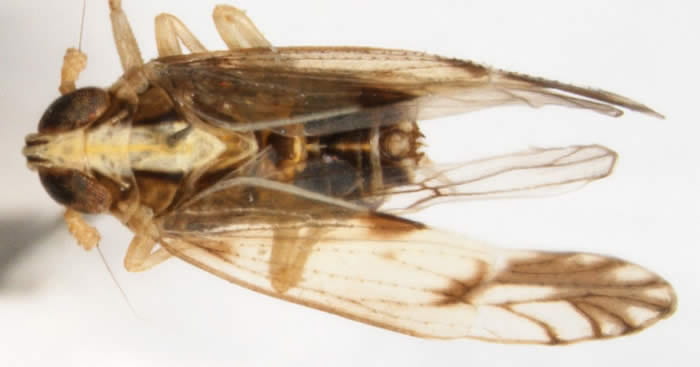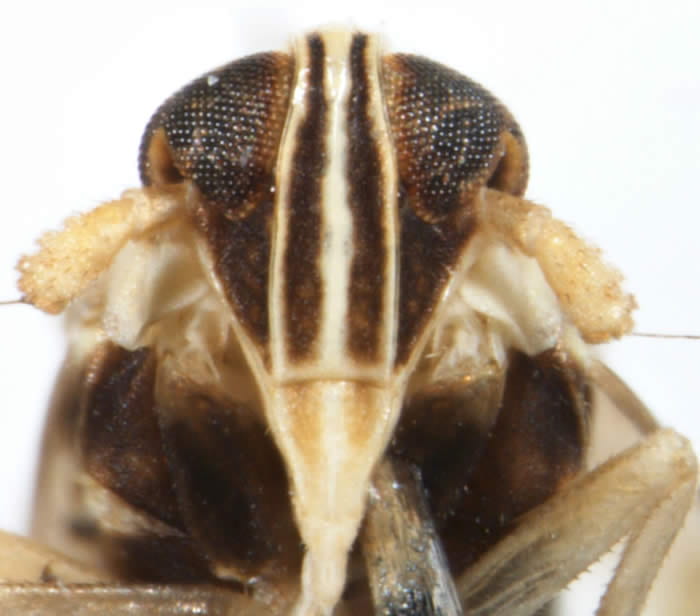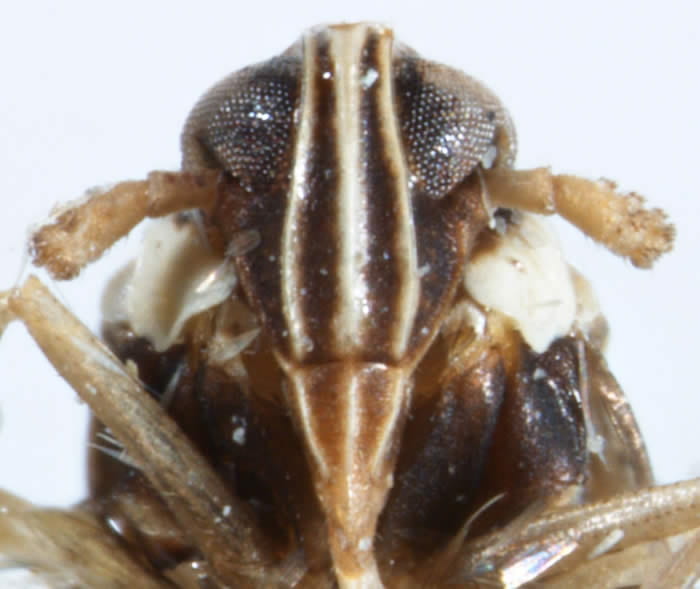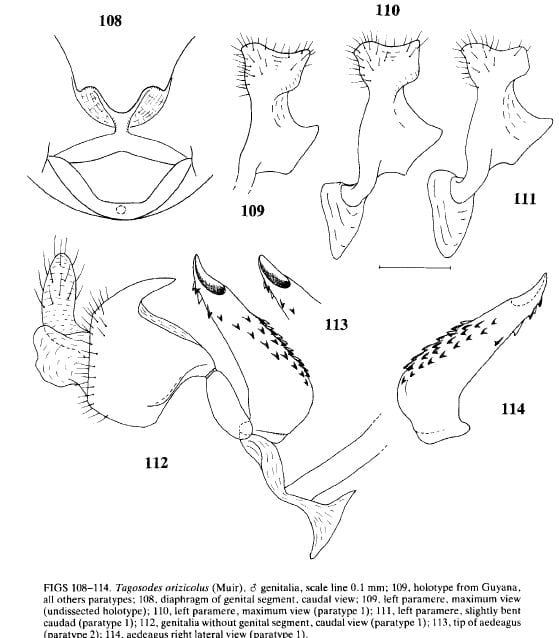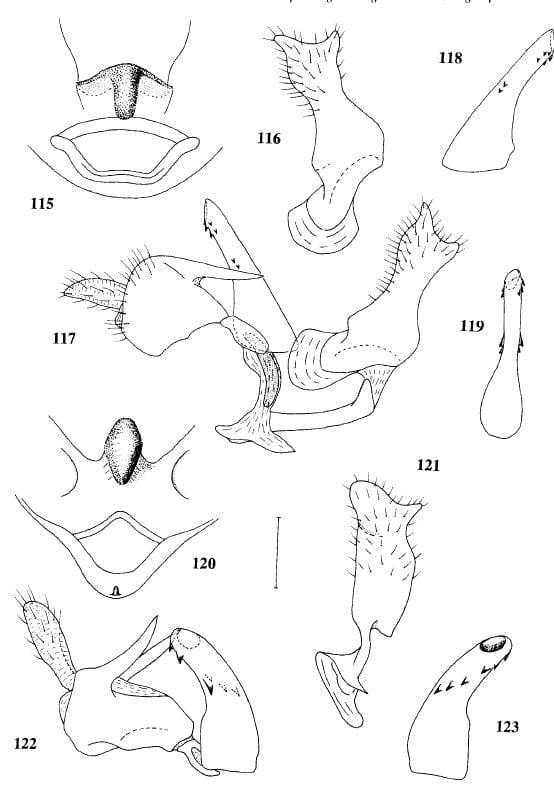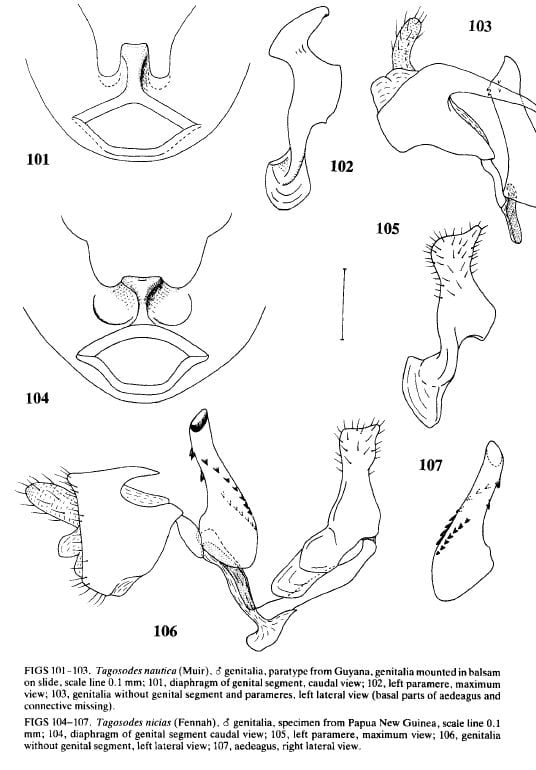[Back to Higher classification of Delphacidae]
Contents
Family Delphacidae Leach, 1815
Subfamily Delphacinae Leach, 1815
Tribe Delphacini Leach, 1815
Genus Tagosodes Asche and Wilson, 1990: 32.
Type species (in original combination): Dicranotropis cubanus Crawford, 1914: 595.
Distribution
Pantropical and adjacent temperate regions.
Recognized Species
There are 20 species worldwide, as follow (distribution records may be incomplete, especially for the Old World):
New World
1 Tagosodes albifacies (Caldwell, 1951 in Caldwell & Martorell 1951) – Puerto Rico
= Sogata albifacies Caldwell, 1951, in Caldwell & Martorell 1951: 173
= Tagosodes albolineosus (Fowler) comb.by Asche and Wilson 1990: 32
2 Tagosodes albolineosus (Fowler, 1905: 135) – USA: FL; Costa Rica, Cuba, ?Jamaica, Mexico (Tabasco, Veracruz), Panama, Puerto Rico, Nicaragua
= Liburnia albolineosa Fowler, 1905: 135.
= Megamelus albolineosus (Fowler, 1905); comb. by Crawford 1914: 610-611.
= Sogata furcifera (Horváth, 1899); syn. by Muir & Giffard 1924: 13 (error).
= Delphacodes albolineosa (Fowler, 1905); comb. by Osborn 1926: 360.
= Sogatodes albolineosus (Fowler, 1905); comb. by Fennah 1963b: 74.
= Tagosodes albolineosus (Fowler, 1905); comb. by Asche & Wilson 1990: 32.
3 Tagosodes anomalus (Muir, 1926) – Brazil (Rio de Janeiro)
= Sogata anomala Muir, 1926a: 27
= Tagosodes anomala (Muir) comb.by Asche and Wilson 1990: 32
4 Tagosodes approximatus (Crawford, 1914: 622) [Metcalf 1943: 351] – USA: FL; Bahamas (Great Inagua); Brazil (Rio de Janeiro, Santa Catarina), Belize, Cayman Islands (Grand Cayman, Cayman Brac), Costa Rica, Honduras, Mexico, Nicaragua, Puerto Rico (inc. Caja de Muertos), Peru, Trinidad, Virgin Islands (St. Thomas), Venezuela
= Megamelus approximatus Crawford, 1914: 622.
= Sogata approximata (Crawford, 1914); comb. by Wolcott 1923: 273.
= Chloriona (Sogatella) approximata (Crawford, 1914); comb. by Fennah 1959: 259.
= Sogatodes approximatus (Crawford, 1914); comb. by Fennah 1963b: 74.
= Tagosodes approximatus (Crawford, 1914); comb. by Asche & Wilson 1990: 32.
5 Tagosodes biangulatus (Muir, 1929) – Argentina
= Sogata biangulata Muir, 1929a: 84.
= Tagosodes biangulata (Muir); comb.by Asche and Wilson 1990: 33.
6 Tagosodes cubanus (Crawford, 1914: 595) – (Common and widely distributed in the Neotropics) USA: FL, NJ?, TX; Bahamas (Great Inagua); Bermuda, Bolivia, Brazil (Santa Catarina, Sao Paulo), Cayman Islands (Grand Cayman, Cayman Brac); Colombia, Costa Rica, Cuba, Dominica, Dominican Republic, Guadeloupe, Honduras, Jamaica, Martinique, Mexico (Colima, Federal District, Guerrero, Hidalgo, Jalisco, Michoacán, Morales, Nayarit, Sinaloa, Tabasco, Veracruz), Nicaragua, Panama, Peru, Puerto Rico (inc. Mona Island), St. Lucia, Suriname, Trinidad, Venezuela, Virgin Islands (St. Croix); (NJ record probably in error)’ Palearctic: Nigeria, Ivory Coast, Sudan, Reunion (adventive?)
= Dicranotropis cubanus Crawford, 1914: 595.
= Dicranotropis cubana Crawford, 1914; emendation by Weiss 1917: 215.
= Megamelus puellis [sic] mexicanus Crawford, 1914: 626.
= Megamelus flavolineatus Muir, 1920: 143; syn. by Wolcott 1923: 273.
= Sogata cubanus (Crawford, 1914); comb. by Wolcott 1923: 273.
= Sogata mexicana (Crawford, 1914); comb. by Muir & Giffard, 1924: 15.
= Sogata cubana (Crawford, 1914); emendation by Muir 1926: 26-28.
= Peregrinus cubana (Crawford, 1914); comb. By Osborn 1926: 358.
= Sogata cubana pallida Osborn, 1935: 243.
= Liburnia cubana (Crawford, 1914); comb. by Metcalf 1943: 354.
= Liburnia cubana pallida (Osborn, 1935); comb. By Metcalf 1943: 254.
= Liburnia mexicana (Crawford, 1914);comb. by Crawford, 1914: 365.
= Chloriona (Sogatella) cubana (Crawford, 1914); comb. by Fennah 1959: 259.
= Sogatodes cubanus (Crawford, 1914); comb. by Fennah 1963b: 74.
= Chloriona (Sogatella) panda Fennah, 1958a: 491-492; syn. by Fennah 1969a: 56.
= Delphacodes pallidivitta Fennah, 1945a: 433-434; syn. by Asche & Wilson 1990: 33.
= Tagosodes cubanus (Crawford, 1914); comb. by Asche & Wilson 1990: 33.
= Liburnia cubana pallida (Osborn, 1935); synonymy in Bartlett et al. 2014.
= Liburnia mexicana (Crawford, 1914); synonymy in Bartlett et al. 2014.
7 Tagosodes dorsolineatus (Beamer, 1952: 112) – USA: Texas
= Sogata dorsolineatus Beamer, 1952a: 112.
= Tagosodes dorsolineatus (Beamer, 1952a); comb. by Asche & Wilson 1990: 33.
8 Tagosodes nauticus (Muir, 1926) – Guyana, Venezuela
= Sogata nautica Muir, 1926a: 26.
= Tagosodes nauticus (Muir); comb.by Asche and Wilson 1990: 34.
9 Tagosodes orizicolus (Muir, 1926) – USA (FL, LA, MS); Argentina, Bolivia, Brazil (Sao Paulo), Cayman Islands (Grand Cayman), Colombia, Costa Rica, Cuba, Dominica, French Guiana, Guatemala, Guyana, Honduras, Mexico (Guerrero), Panama, Paraguay, Peru, Puerto Rico, Suriname, Trinidad, Uruguay, Venezuela (common and widely distributed in the Neotropics)
= Sogata orizicola Muir, 1926: 27.
= Liburnia orizicola (Muir, 1926); comb. Metcalf 1943: 366, 547.
= Liburnia brazilensis (Muir, 1926); comb. by Metcalf 1943: 353, 547.
= Chloriona (Sogatella) orizicola (Muir, 1926); comb. by Fennah 1959: 259.
= Sogatodes orizicola (Muir, 1926); comb. by Fennah 1963b: 74.
= Sogatodes brazilensis (Muir, 1926); comb. by Fennah 1963b: 74.
= Sogata brazilensis Muir, 1926:26; syn. by Fennah 1965b: 215-217.
= Tagosodes orizicolus (Muir, 1926); comb. and emendation by Asche & Wilson 1990: 34-35.
10 Tagosodes wallacei (Muir and Giffard, 1924) – USA: FL, TX; Mexico (Guerrero); Belize, Brazil (Bahia), Colombia, Cuba, Dominica, Ecuador, Guyana, Honduras, Jamaica, Panama, Puerto Rico, Peru (?Honduras)
= Sogata wallacei Muir & Giffard, 1924: 13.
= Liburnia wallacei (Muir & Giffard, 1924); comb. by Metcalf, 1943: 371.
= Chloriona (Sogatella) wallacei (Muir & Giffard, 1924); bomb. by Fennah, 1959: 259.
= Sogatella wallacei (Muir & Giffard, 1924); new status by implication Fennah, 1963: 48.
= Tagosodes wallacei (Muir & Giffard, 1924); comb. by Asche & Wilson, 1990: 7, 36.
= Delphacodes ardentis Beamer, 1948c: 113-114; synonymy in Bartlett et al. 2014.
Old World
1 Tagosodes baina (Ding and Kuoh, 1981: 192 in Kuoh et al. 1981) – China
= Himeunka baina Ding & Kuoh, 1981, in Kuoh et al., 1981: 24.
= Tagosodes baina (Ding & Kuoh) comb.by Asche and Wilson 1990: 32.
2 Tagosodes candiope (Fennah, 1975: 97) – Sri Lanka
= Sogatodes candiope Fennah, 1975: 97.
= Tagosodes candiope (Fennah) comb. by Asche and Wilson 1990: 33.
3 Tagosodes elpenor (Fennah, 1964) – Mauritius, Reunion, Taiwan
= Sogatodes elpenor Fennah, 1964.
= Tagosodes elpenor (Fennah, 1964); comb. by Asche & Wilson (1990: 33).
4 Tagosodes flaviceps (Muir, 1929) – South Africa
= Opiconsiva flaviceps Muir, 1929
= Tagosodes flaviceps (Muir, 1929); comb. by Asche & Wilson (1990: 33-34)
5 Tagosodes incanus (Yang, 1989) – Taiwan
= Sogatodes incanus Yang, 1989: 176.
= Tagosodes incanus (Yang) comb.by Asche and Wilson 1990: 34.
6 Tagosodes melicerta (Fennah, 1958: 460) – Ivory Coast, Guinea-Bissau (Portuguese Guinea)
= Chloriona (Sogatella) melicerta Fennah, 1958c: 490.
= Tagosodes melicerta (Fennah, 1958); comb. by Asche and Wilson 1990: 34.
= Sogatodes neomphala Asche, 1988; Synonym byAsche and Wilson 1990: 34.
7 Tagosodes nicias (Fennah, 1965: 45) – Papua New Guinea
= Sogatodes nicias Fennah, 1965b: 45.
= Tagosodes nicias (Fennah); comb.by Asche and Wilson 1990: 34.
8 Tagosodes pusanus (Distant, 1912: 191) – Taiwan, Philippines, Micronesia, Sri Lanka, India, Pakistan, China Indonesia (Suliwesi)
= Sogata pusana distant, 1912: 191 (India).
= Kelisia fieberi Muir, 1917: 331 (Philippines), syn. by Fennah, 1971a: 574.
= Unkana formosella Matsumura, 1935: 72; (Taiwan), syn. by Fennah, 1971a: 574.
= Sogata striatus Qadri & Mirza, 1960: 117 (Pakistan) nomen nudum (invalid under article 13 of the code of Zoological Nomenclature (1985); syn. by Asche and Wilson 1990: 34.
= Himeunka chibana Tian & Kuoh, 1981, in Kuoh et al., 1981: 193 (China). Syn.by Asche and Wilson 1990: 36.
= Sogatodes assimilis Yang 1989: 178 (Taiwan); Syn. by Asche and Wilson 1990: 36.
= Tagosodes pusanus (Distant); comb.by Asche and Wilson 1990: 34.
9 Tagosodes sternalis (Distant, 1916: 139) – Sri Lanka
= Sogata sternalis Distant, 1916: 139 (Sri Lanka).
= Tagosodes sternalis (Distant) comb. by Asche and Wilson 1990: 36.
10 Tagosodes timaea (Fennah, 1969: 56) – Sudan
= Sogatella timaea Fennah, 1969b: 56 (Sudan).
= Tagosodes timaea (Fennah); comb.by Asche and Wilson 1990: 36.
Plant associations
Tagosodes cubanus and T. orizicolus are both rice pests in the Neotropics. Both species are recorded from Oryza sativa L. (rice), Echinochloa sp. (cockspur grass), Cocos nucifera L. (coconut palm).
Tagosodes cubanus – Chloris gayana Kunth, Echinochloa sp., Festuca sp., Hemarthria altissima (Poir.) Stapf & C.E. Hubb., Oryza sativa L., Pennisetum clandestinum Hochst. ex Chiov., Saccharum officinarum L., Setaria sphacelata (Schumach.) Stapf & C.E. Hubb. ex M.B. Moss, Zea mays L. (Poales, Poaceae; Bonfils et al. 1994); Cocos nucifera L. L. (Arecales, Arecaceae; Bonfils et al. 1994)
Tagosodes albolineous has been found in abundance on Paspalum fluitans (Elliott) Kunth in Florida
Tagosodes elpenor – Pennisetum clandestinum Hochst. ex Chiov.. Setaria sphacelata (Schumach.) Stapf & C.E. Hubb. ex M.B. Moss (Poaceae; Bonfils et al. 1994)
Tagosodes melicerta – Oryza sativa L (rice)
Tagosodes orizicolus – Oryza sativa L (rice), Echinochloa sp. (cockspur grass)
Plant names according to the PLANTS Database (http://plants.usda.gov). Sources Wilson and O;Brien 1987, Wilson et al. 1994, Bonfils et al. 1994; see FLOW for plant associations I might have missed.
Predation/parasitism
Tagosodes melicerta – Psenulus sp. (Hymenoptera, Crabronidae; Etienne et al. 1992: 167)
Economic importance
Tagosodes cubanus is a vector of Rice hoja blanca tenuivirus (RHBV)
Tagosodes orizicolus is a vector of Mal de Rio Cuarto fijivirus (MRCV), and Rice hoja blanca tenuivirus (RHBV)
Quote from Plantwise technical factsheet:
T. orizicolus is the main vector of Rice hoja blanca virus (RHBV), one of the most destructive rice diseases in the Western Hemisphere (Everett and Lamey, 1969). Like many other vectors, T. orizicolus causes direct feeding damage, which can be economically significant in the absence of the virus when insect field populations are high. During severe insect infestations in 1964 and 1965 in Colombia, direct damage reduced rice yields to 600 to 800 kg/ha as against the normal yield of 3000 to 5000 kg/ha (Jennings and Pineda, 1971).
The RHBV-T. orizicolus complex has caused serious production losses in Latin America. RHBV caused an endemic disease on rice in Colombia as early as 1935 (Garces, 1940, 1941). However, the disease did not become significant until 1956 when improved varieties from other countries were planted extensively (Galvez, 1969). Atkins and Adair (1957) estimated the rice crop losses to be 25% in Cuba and 50% in Venezuela with losses in certain fields as high as 75% (USDA-ARS, 1960). Major epiphytotics occurred in Cuba from 1954 to 1956 (Atkins and Adair, 1957) and the disease virtually disappeared from most of the regions of Latin America for nearly 15 years (Galvez, 1969). In 1981, serious widespread outbreaks recurred in Colombia, Ecuador and Venezuela, causing losses up to 100% (Vargas, 1985) since severely affected fields may not be harvested (Jennings, 1963).
Recognition
This genus is very similar to Sogatella (and to a lesser degree Distantinus ). All species tend to be brown (Tagosodes is frequently darker than Sogatella) with a conspicuous pale stripe down the midline of the dorsum. Like Sogatella, color can be both helpful and misleading, particularly since color intensity varies between males and females of the same species and between individuals from different localities. Recognition of species can be difficult, and with some exceptions, requires males. Some species can be very common and are found in considerable numbers. Individuals can travel considerable distances and may be found well outside their usual range (possibly explaining the New Jersey record for Tagosodes cubanus).
Tagosodes can be separated from Sogatella best by the shape of the genital diaphragm of the male – which is broadly “u” shaped in Sogatella versus a rectangular protrusion or raise T-shaped area in Tagosodes.
Tagosodes albolineosus

Tagosodes albolineosus from Fennah 1963 (A. Face; B. head and prothorax, dorsal view; C. head and prothorax lateral view; D. pygofer, caudal view, with postgenital segments, parameres and aedeagal complex removed; E. segment 10, left lateral view; F. aedeagus, left lateral view; G. right paramere, widest view).
Below – Excellent live photos of Tagosodes albolineosus on Paspalum repens (= Paspalum fluitans (Elliott) Kunth, horsetail paspalum) in Florida, courtesy Lyle Buss (University of Florida, Department of Entomology and Nematology, Florida Plant Diagnostics Network)
Adult
Tagosodes albolineosus adult on Paspalum repens
On host – Paspalum repens (= Paspalum fluitans (Elliott) Kunth)

Tagosodes albolineosus on Paspalum repens (= Paspalum fluitans (Elliott) Kunth, horsetail paspalum) in Florida, courtesy Lyle Buss (University of Florida, Department of Entomology and Nematology, Florida Plant Diagnostics Network)
Nymph
Tagosodes albifacies (Caldwell 1951)
Tagosodes anomalus
Tagosodes approximatus
Tagosodes approximatus From Caldwell & Martorell 1951.
Tagosodes cubanus
Tagosodes dorsolineatus – male
Tagosodes dorsolineatus from Beamer 1952
Tagosodes dorsolineatus – female
Tagosodes orizicolus – male
Tagosodes orizicolus on rice (LSU ag center)Tagosodes pusanus (the pale frons is a female brachypter)
Tagosodes wallacei
Plates from Asche and Wilson 1990
Online resources
Tagosodes orizicolus on Leafhopper, Planthopper & Psyllid Vectors of Plant Disease.
3i.
EOL.
Bugguide. (genus not available, link to subfamily)
Discover Life.
FLOW.
Hoppers of North Carolina.
American Insects.
GBIF.
Forestry images.
BOLD.
Invasive.org.
Plantwise knowledge bank.
Molecular resources
There are 3 Tagosodes species (pusanus, orizicolus, and wallacei) currently available on Genbank; and there are 2 species (cubanus and orizicolus) currently on Barcode of Life. (as of 2 Oct. 2017)
Selected references
Arias, M., M. Vivas and A. Pantoja. 1993. Parasitization of Tagosodes orizicolus and T. cubanus in northeastern Colombian ricefields. I International Rice Research Newsletter 18(2): 32.
Asche, M. 1988b. Delphacidae from Cote d’Ivoire (Homoptera, Fulgoroidea). Revue Francaise d’Entomologie (Nouvelle Serie) 10: 151-231.
Asche, M. and M. R. Wilson. 1990. The delphacid genus Sogatella and related groups: a revision with special reference to rice-associated species (Homoptera: Fulgoroidea). Systematic Entomology 15: 1-42.
Atkins, J. G. and C. R. Adair. 1957. Recent Discovery of hoja blanca, a new rice disease in Florida, and a varietal resistance tests in Cuba and Venezuela. Plant Disease Reporter 41(11): 911-915.
Attié M., T. Bourgoin, J. Veslot and A. Soulier-Perkins. 2008. Patterns of trophic relationships between planthoppers (Hemiptera: Fulgoromorpha) and their host plants on the Mascarene Islands. Journal of Natural History 42(23-24): 1591-1638.
Bartlett, C. R. and G. Kunz. 2015. A new genus and species of delphacid planthopper (Hemiptera: Fulgoroidea: Delphacidae) from Central America with a preliminary regional species list. Zootaxa 3946(4): 510-518. doi: 10.11646/zootaxa.3946.4.2. [erratum subsequently published Zootaxa 3963 (4): 598–600; http://dx.doi.org/10.11646/zootaxa.3963.4.7]
Bartlett, C. R., L. B. O’Brien and S. W. Wilson. 2014. A review of the planthoppers (Hemiptera: Fulgoroidea) of the United States. Memoirs of the American Entomological Society 50: 1-287.
Beamer, R. H. 1948c. Some new species of Delphacodes (continued) (Homoptera-Fulgoridae-Delphacinae). Part V. Journal of the Kansas Entomological Society 21: 111‑119.
Beamer, R. H. 1952. One old and five new species of delphacine fulgorids (Homoptera: Fulgoridae). Journal of the Kansas Entomological Society 25(3): 111-115.
Bonfils J., S. Quilici and B. Reynaud. 1994. Les Hémiptères Auchénorrhynques de l’Ile de la Réunion. Bulletin de la Société Entomologique de France 99: 227-240.
Caldwell, J. S. and L. F. Martorell. 1951 [dated 1950]. Review of the Auchenorynchous [sic] Homoptera of Puerto Rico. Part II. The Fulgoroidea except Kinnaridae. Journal of Agriculture of the University of Puerto Rico 34(2): 133-269.
Crawford, D. L. 1914a. A contribution toward a monograph of the homopterous insects of the family Delphacidae of North and South America. Proceedings of the United States National Museum 46: 557-640, plus 6 plates.
Denno, R. F., G. K. Roderick and K. L. Olmstead. 1991. Density-related migration in planthoppers (Homoptera: Delphacidae): the role of habitat persistence. American Naturalist 138: 1513-1541.
Distant, W. L. 1912a. Descriptions of new genera and species of Oriental Homoptera. Annals and Magazine of Natural History (Ser. 8) 9: 181-193.
Distant, W. L. 1916a. Rhynchota Homoptera: Appendix Vol. VI. In: A.E. Shipley, (ed.). The Fauna of British India including Ceylon and Burma. Taylor & Francis, London. 6: i-vii, 1-248.
Etienne J., G. Delvare and H.-P. Aberlenc. 1992. Contribution à lа connaissance de I’arthropodofaune associée аuх cultures de Casamance (Senegal). Bollettino di Zoologia agraria e di Bachicoltura II, 24(2): 159-193.
Everett, T. R. and H. A. Lamey. 1969. Hoja blanca. Pp. 361-377. In: K. Maramorosch (Ed.). Viruses, Vectors and Vegetation. Interscience Publishers, New York. 666 pp.
Fennah, R. G. 1958. Fulgoroidea from west Africa. Bulletin de l’institute Francaises de Afrique Noire 20. Series A Pp. 20:460-538.
Fennah, R. G. 1959. Delphacidae from the Lesser Antilles (Homoptera: Fulgoroidea). Bulletin of the British Museum (Natural History) Entomology 8: 245-265.
Fennah, R. G. 1963. The Delphacid-species-complex known as Sogatella furcifera (Horvath) (Homoptera: Fulgoroidea). Bulletin of Entomological Research 54(1): 45-79.
Fennah, R. G. 1965. Delphacidae from Australia and New Zealand (Homoptera: Fulgoroidea). Bulletin of the British Museum (Natural History) Entomology 17(1): 1-59.
Fennah, R. G. 1969. Delphacidae (Homoptera: Fulgoroidea) from the Sudan Republic. Acta Entomologica Fennica 26:1-78.
Fennah, R. G. 1971a. Fulgoroidea from the Cayman Islands and adjacent Areas. Journal of Natural History 5: 299-342.
Fennah, R. G. 1975. Homoptera: Delphacidae from Ceylon. Entomologica Scandinavica (Supplement) 4: 79-136.
Fowler, W. W. 1905a. Order Rhynchota. Suborder Hemiptera-Homoptera. (Continued). Biologia Centrali-Americana 1:125-139. Plate(s): 13.
Garces-Orejuela, C. 1940. Informe de una Comissoin para estudiar y para presentar un plan de organizacion de projectos en patologia de plantas en la Estacion Agricola Experimental de Palmira. [Unnumbered report to Minisrer of National Economy, Bogata, Colombia] [this and next cited in Plantwise]
Garces-Orejuela, C. 1941. Enferyriedads del Arroz. Unnumbered report, Palmira, Colombia.
Galvez, G. E. 1969a. Hoya blanca disease of Rice. Pp. 35-49. In: The virus diseases of the rice plant. John Hopkins, Baltamore/IRRI, Philippines.
Galvez, G. E. 1969b. Transmission of Hoya Blanca virus of Rice. Pp. 155-163. In: The virus diseases of the rice plant. John Hopkins, Baltamore/IRRI, Philippines.
Hernandez, M., T. Quesada, C. Munoz and A. M. Espinoza. 2004. Genetic diversity of Costa Rican populations of the rice planthopper Tagosodes orizicolus (Homoptera: Delphacidae). Revista de Biologia Tropical 52(3): 795-806.
Jennings, P. R. 1963. Estimating yield loss in rice caused by hoya blanca. Phytopathology 53: 492.
Jennings, P. R. and A. Pineda. 1971. The effect of the hoya blanca virus on its insect vector. Phytopathology 61: 142-143.
Kennedy, A. C., C. R. Bartlett and S. W. Wilson. 2012. An annotated checklist of the delphacid planthoppers (Hemiptera: Delphacidae) of Florida with the description of three new species and the new genus, Meristopsis. Florida Entomologist 95(2): 395-421.
Kuoh, C. L., J. H. Ding and L. X. Tian. 1981. A revision of the genus Himeunka Matsumura et Ishihara (Homoptera, Delphacidae). Acta Entomologica Sinica 24(2): 190-195.
Leach, W. E. 1815a. Entomology. The Edinburg encyclopedia; conducted by David Brewster 9: 57-172. (family Delphacidae here).
Llano C. A., C. R. Bartlett and G. Guevara. 2016. First record of the subfamily Asiracinae and Copicerus irroratus (Hemiptera: Auchenorrhyncha: Delphacidae) in Colombia. Florida Entomologist 99(1): 120-122.
Macaya-Lizano, A. V., R. Pereira and A. M. Espinoza. 1997. Comparison of two tissue preparation methods to study the internal anatomy of the delphacid Tagosodes orizicolus with light and electron microscopy. Revista de Biologia Tropical 45(2): 927-932.
Mattio, M. F., A. Cassol, A. M. de Remes Lenicov and G. Truol. 2008. Tagosodes orizicolus: nuevo vector potencial del Mal de Río Cuarto virus. Tropical Plant Pathology 33(3): 237-240.
Metcalf, Z. P. 1943. General Catalogue of the Hemiptera. Fascicle IV, Fulgoroidea, Part 3, Araeopidae (Delphacidae). Smith College, Northhampton, Massachusetts.
Miskimen, G. W. and R. M. Bond. 1970. The Insects of St. Croix, United States Virgin Islands. Scientific Survey of Porto Rico and the Virgin Islands, New York Academy of Sciences. 12: 1-114.
Mora, R., A. Retana and A. M. Espinoza. 2001. External morphology of Tagosodes orizicolus (Homoptera: Delphacidae) revealed by scanning electron microscopy. Annals of the Entomological Society of America 94(3): 438-448.
Mora-Kepfer, R. and A. M. Espinoza. 2009. Parasitism and predation of the planthopper Tagosodes orizicolus (Homoptera: Delphacidae) by a dryinid parasitoid in Costa Rica. Revista de Biologia Tropical 57(Suppl. 1): 203-211.
Muir, F.A.G. 1926b. Contributions to our knowledge of South American Fulgoroidea (Homoptera). Part I. The Family Delphacidae. Experiment Station of the Hawaiian Sugar Planters’ Association, Entomological Series, Bulletin 18:1-51, plates 1-5.
Muir, F.A.G. 1929b. New and little-known African-Delphacidae (Homoptera, Fulgoroidea) in the collection of the British Museum. Annals and Magazine of Natural History (series 10) 4:186-222.
Muir, F.A.G. and W. M. Giffard. 1924a. Studies in North American Delphacidae. Bulletin of the Experiment Station of the Hawaiian Sugar Planters’ Association, Entomological series no. 15: 1-53.
Rodriguez-León, R., M. M. Hidalgo-Gatov and N. Novo. 1994a. Fulgoroideos en la cana de azúcar y la vegetación sinantrópica [Fulgoroidea on sugar cane and border plant communities]. Ciencias Biologicas Academia de Ciencias de Cuba 27: 18-23.
Sanchez-Soto, S., J. A. Jimenez-Chong and M. Zetina-Lanz. 1999. Tagosodes orizicolus (Homoptera, Delphacidae), a rice pest in the region of Chontalpa, Tabasco state, Mexico. Folia Entomologica Mexicana 1999(106): 125-126 [In Spanish].
Triana, E. M., A. Pineda, C. Pardey, A. Pantoja and M. C. Duque. 1994. Mecanismos de resistencia al dano mecanico por Tagosodes orizicolus (Muir) (Sogatodes orizicola) en arroz. Revista Colombiana de Entomologia 20(1): 23-26.
Tsai, J. H. and F. W. Mead. 1982. Rotary net survey of homopterans in palm plantings in south Florida. Journal of Economic Entomology 75: 809-812.
USDA Agricultural Research Service. 1960. Hoya blanca, serious threat to rice crops. ARS 22-57. 14pp.
Vargas, H. P. 1985. La hoja blanca: descalabro de CICA-8. Arroz, Bogota (Colombia) 34:18-19.
Vivas, C., E. Luis and S. Clacijo. 2000. Fluctuacion poblacional de Tagosodes orizicolus (Muir) 1926 (Homoptera: Delphacidae) en el sistema de riego Rio Guarico, Calabozo, estado Guarico, Venezuela. Boletín de Entomología Venezolana 15(2): 217-227.
Wilson, M. R. and M. F. Claridge. 1991. Handbook for the identification of leafhoppers and planthoppers of rice. C.A.B. International, Wallingford, Oxon. 142 pp.
Wilson, M. R. and D. J. Hilburn. 1991. Annotated list of the auchenorrhynchous Homoptera (Insecta) of Bermuda. Annals of the Entomological Society of America 84: 412‑419.
Wilson, S. W. 2005. Keys to The families Of Fulgoromorpha with emphasis on planthoppers of potential economic importance in the southeastern United States (Hemiptera: Auchenorrhyncha). Florida Entomologist 88(4): 464-481.
Wilson, S. W. and L. B. O’Brien. 1987. A survey of planthopper pests of economically important plants (Homoptera: Fulgoroidea). Pp. 343-360. In: M.R. Wilson and L.R. Nault,(eds.). Proceedings of the 2nd International Workshop on Leafhoppers and Planthoppers of Economic Importance : Brigham Young University, Provo, Utah, USA, 28th July-1st August 1986. CAB International Institute of Entomology.
Wilson, S. W. and J. E. McPherson. 1980b. The distribution of the Fulgoroidea of the eastern United States (Homoptera). Transactions of the Illinois Academy of Science 73(4): 7‑20.
Wilson, S. W., C. Mitter, R. F. Denno and M. R. Wilson. 1994. Evolutionary patterns of host plant use by delphacid planthoppers and their relatives. In: R. F. Denno and T. J. Perfect, (eds.). Planthoppers: Their Ecology and Management. Chapman and Hall, New York. Pp. 7-45 & Appendix [host references in appendix].
Wolcott, G. N. 1950 [dated 1948]. The insects of Puerto Rico. Journal of Agriculture of the University of Puerto Rico 32: 1-224.
Xet-Mull, A. M., T. Quesada, T. and A. M. Espinoza. 2004. Phylogenetic position of the yeast-like symbiotes of Tagosodes orizicolus (Homoptera: Delphacidae) based on 18S ribosomal DNA partial sequences. Revista de Biologia Tropical 52(3): 777-785.
Yang, C. T. 1989. Delphacidae of Taiwan II (Homoptera: Fulgoroidea). NSC Special Publications 6: 1-334.
Zeigler, R. S., A. Pantoja, M. C. Duque and G. Weber. 1994. Characteristics of resistance in rice to rice hoja blanca virus (RHBV) and its vector, Tagosodes orizicolus (Muir). Annals of Applied Biology 124(3): 429-440.

